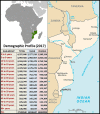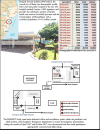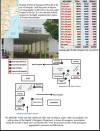Differential patterns of disease and injury in Mozambique: New perspectives from a pragmatic, multicenter, surveillance study of 7809 emergency presentations
- PMID: 31291292
- PMCID: PMC6619685
- DOI: 10.1371/journal.pone.0219273
Differential patterns of disease and injury in Mozambique: New perspectives from a pragmatic, multicenter, surveillance study of 7809 emergency presentations
Abstract
Background: There is a paucity of primary data to understand the overall pattern of disease and injuries as well as related health-service utilization in resource-poor countries in Africa.
Objective: To generate reliable and robust data describing the pattern of emergency presentations attributable to communicable disease (CD), non-communicable disease (NCD) and injuries in three different regions of Mozambique.
Methods: We undertook a pragmatic, prospective, multicentre surveillance study of individuals (all ages) presenting to the emergency departments of three hospitals in Southern (Maputo), Central (Beira) and Northern (Nampula) Mozambique. During 24-hour surveillance in the seasonally distinct months of April and October 2016/2017, we recorded data on 7,809 participants randomly selected from 39,124 emergency presentations to the three participating hospitals. Applying a pragmatic surveillance protocol, data were prospectively collected on the demography, clinical history, medical profile and treatment of study participants.
Findings: A total of 4,021 males and 3,788 (48.5%) females comprising 630 infants (8.1%), 2,070 children (26.5%), 1,009 adolescents (12.9%) and, 4,100 adults (52.5%) were studied. CD was the most common presentation (3,914 cases/50.1%) followed by NCD (1,963/25.1%) and injuries (1,932/24.7%). On an adjusted basis, CD was more prevalent in younger individuals (17.9±17.7 versus 26.6±19.2 years;p<0.001), females (51.7% versus 48.7%-OR 1.137, 95%CI 1.036-1.247;p = 0.007), the capital city of Maputo (59.6%) versus the more remote cities of Beira (42.8%-OR 0.532, 95%CI 0.476-0.594) and Nampula (45.8%-OR 0.538, 95%CI 0.480-0.603) and, during April (51.1% versus 49.3% for October-OR 1.142, 95%CI 1.041-1.253;p = 0.005). Conversely, NCD was progressively more prevalent in older individuals, females and in the regional city of Beira, whilst injuries were more prevalent in males (particularly adolescent/young men) and the northern city of Nampula. On a 24-hour basis, presentation patterns were unique to each hospital.
Interpretation: Applying highly pragmatic surveillance methods suited to the low-resource setting of Mozambique, these unique data provide critical insights into the differential pattern of CD, NCD and injury. Consequently, they highlight specific health priorities across different regions and seasons in Southern Africa.
Conflict of interest statement
The authors have declared that no competing interests exist.
Figures











Similar articles
-
Injury caseload, pattern and time of presentation to emergency services in Mozambique: A pragmatic, multicentre, observational study.Injury. 2025 Jun;56(6):112332. doi: 10.1016/j.injury.2025.112332. Epub 2025 Apr 8. Injury. 2025. PMID: 40273658
-
Incorporating selected non-communicable diseases into facility-based surveillance systems from a resource-limited setting in Africa.BMC Public Health. 2019 Feb 4;19(1):147. doi: 10.1186/s12889-019-6473-2. BMC Public Health. 2019. PMID: 30717732 Free PMC article.
-
Pediatric emergency care in a low-income country: Characteristics and outcomes of presentations to a tertiary-care emergency department in Mozambique.PLoS One. 2020 Nov 4;15(11):e0241209. doi: 10.1371/journal.pone.0241209. eCollection 2020. PLoS One. 2020. PMID: 33147242 Free PMC article.
-
Setting the scene and generating evidence for malaria elimination in Southern Mozambique.Malar J. 2019 Jun 6;18(1):190. doi: 10.1186/s12936-019-2832-9. Malar J. 2019. PMID: 31170984 Free PMC article. Review.
-
[SENTIERI - Epidemiological Study of Residents in National Priority Contaminated Sites. Sixth Report].Epidemiol Prev. 2023 Jan-Apr;47(1-2 Suppl 1):1-286. doi: 10.19191/EP23.1-2-S1.003. Epidemiol Prev. 2023. PMID: 36825373 Italian.
Cited by
-
Changing patterns in the burden of paediatric injuries during the COVID-19 pandemic: a study in Mozambique's central hospitals.BMC Health Serv Res. 2023 Oct 6;23(1):1071. doi: 10.1186/s12913-023-10073-x. BMC Health Serv Res. 2023. PMID: 37803444 Free PMC article.
-
Empowering Frontline Primary Healthcare Workers in a Global Health Partnership Training of Trainers Intervention to Strengthen the Prevention and Control of Cardiovascular Disease in Mozambique.Glob Heart. 2022 Aug 2;17(1):51. doi: 10.5334/gh.1052. eCollection 2022. Glob Heart. 2022. PMID: 36051314 Free PMC article.
-
Retention of patient-held medical records for chronic diseases in Mozambique.Pan Afr Med J. 2021 May 1;39:1. doi: 10.11604/pamj.2021.39.1.22504. eCollection 2021. Pan Afr Med J. 2021. PMID: 34178229 Free PMC article.
-
Hypertension in a resource-limited setting: Poor Outcomes on Short-term Follow-up in an Urban Hospital in Maputo, Mozambique.J Clin Hypertens (Greenwich). 2019 Dec;21(12):1831-1840. doi: 10.1111/jch.13732. Epub 2019 Nov 25. J Clin Hypertens (Greenwich). 2019. PMID: 31769184 Free PMC article.
-
Assessment of critical resource gaps in pediatric injury care in Mozambique's four largest Hospitals.PLoS One. 2023 Jun 1;18(6):e0286288. doi: 10.1371/journal.pone.0286288. eCollection 2023. PLoS One. 2023. PMID: 37262032 Free PMC article.
References
-
- Benie Bi Vroh J, Tiembre I, Ekra DK, Ano Ama MN, Ka OM, Ncho Dagnan S, et al. Determinants of Fatal Road Traffic Injuries in Cote d'Ivoire from 2002 to 2011. Sante Publique. 2016;28(5):647–53. - PubMed
-
- World Health Organization. Global action plan for the prevention and control of noncommunicable diseases 2013–2020. Geneva, Switzerland: World Health Organization; 2013.
Publication types
MeSH terms
LinkOut - more resources
Full Text Sources
Medical
Miscellaneous

